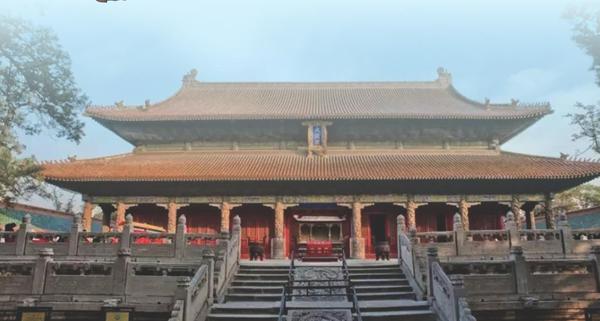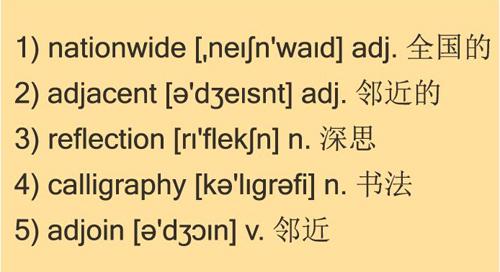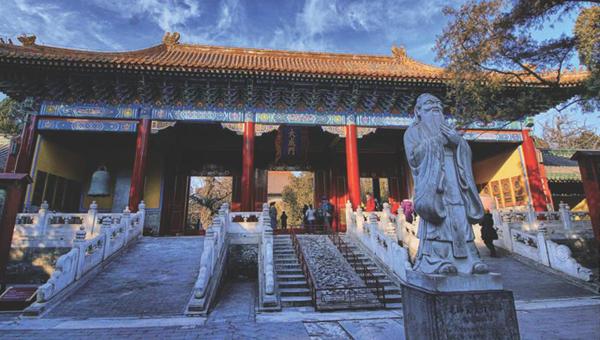Discovering Confucius
Bruce Connlly



想要體会儒家文化,那就绕不开一个人一孔子。作者讲述了他经历和了解的中国各地关于孔子的一些庙宇和学校,把所见所闻慢慢拼成了一幅大图景,让人更宏观地认识了中国,包括其让人着迷的儒家文化。
To understand some of China's history, it is useful to appreciate Confucius. So where better to start than some of the temples and schools dedicated to him lnationwide? In the mid-1990s I lived along a traditional Beijing hutong, a short walk from Lama Temple or Yonghegong. Nearby sat Beijing's Confucian Temple or Kong Miao, and the 2)adjacent former Imperial College. Throughout several dynasties that school was the national center of administration for learning in a very traditional educational system. It included the teachings of Confucius and a very strict examination requiring intensive personal study.
During my early years exploring the area, the temple was often quiet.I found it excellent for relaxation and 3)reflection. Its crimson-colored buildings represented a grand Ming Dynasty architectural style although construction initially dated from 1302 during the Yuan period. After Qufu, it is China's second-largest Confucian temple. Today classes on early Chinese culture including Confucian philosophy, 4)calligraphy, music and more are held within some of its smaller halls.
I would go on to discover more of the Confucian influence. In 2017, I visited Pingyao in Shanxi province. From the walls still enclosing the Old Town I looked across to the sloping roof of its Confucian temple, known as “Wenmiao". Founded as early as the Tang Dynasty (618-908 AD),it is one of the oldest and best preserved structures of its kind in China. It was a personaljoy to stay in a hotel built in the historic Chinese style and literally 5adjoining the temple.
Nanjing was another city where I experienced elements of Confucian heritage.Nanjing, whose name literally means“Southern Capital", had an active temple in what is today the Fuzimiao tourist district on the north 6bank of the Qinhuai River. That temple dates from 1034, though the current structure was built in the 19th century. When I first visited in 1996, it was a quiet area, but what I wanted to see were the exam 7booths. Stories abound of students confined into 8lcramped spaces, spending considerable time trying to achieve the highest possible grade. That was many years ago, but when I came to China in 1992 to work within the higher education sector of Guangdong, I personally witnessed students studying for many hours. I still see elements of this in the modern bookstores opening across China.
I have always felt that it is the people who make a city, something I certainly feel about Tianjin. I recently delighted in exploring its Confucian Temple. One of the oldest buildings in Tianjin, it is also the largest traditional architectural structure in the city. It has survived since the Ming Dynasty (1368-1644) largely 9lintact. Almost palace- like in design, it features decorative archways, goldfish ponds and llancestral hallswhere students would pray for success in their academic studies.
It is only a short distance along the Haihe River from that temple to the Shangri-La Hotel. There I found the recent cultural performances centering around Confucius quite lstimulating. Watching the rituals unfold had me thinking again of China, of no matter how long we stay here there is always something new todiscover. There is so much to revisit to gradually put together a picture of whatI feel constitutes China, including its fascinating Confucian heritage.
想要對中国历史有些了解,先去认识孔子这个人是非常有用的。学习之旅的最佳起点莫过于中国各地关于孔子的一些庙宇和学校了吧。20世纪90年代中期,我住在一条老北京胡同里,距离雍和宫就一小段路程,北京孔庙和与之相邻的国子监也在附近。那所学府在好几个朝代都是国家的教育管理中心,实行非常传统的教育体制,教学内容包含孔子学说,考试很严格,要求学生自主勤奋学习。
起初那几年我在这片地区四处游逛的时候,孔庙里常常很安静,是个让我觉得可以休息放松、静心思考的好地方。北京孔庙虽然始建于元朝时期的1302年,但建筑群整体呈深红色,体现了明朝恢宏的建筑风格。它仅次于曲阜孔庙,是中国第二大的孔子庙。如今,在几个比较小的礼厅里会上一些关于中国古代文化的课,包括儒学、书法、音乐等。
我继续着旅程,去发现更多儒家文化的影响。2017年,我去了山西省的平遥县。这座古城仍然被一堵堵城墙包围着,这里的孔子庙也叫文庙,由城墙处望去,我看到了文庙的斜面屋顶。早在唐朝时期(618-907),文庙就动工开建,是中国国内历史最悠久、保存最完好的古建筑之一。而就在文庙近旁有一家古香古色的酒店,住在这样的地方真是让我觉得身心愉悦。
南京是另一个我感受儒家文化要素的城市。南京这个名字的字面意思是“南方之都”,在秦淮河北岸如今夫子庙旅游景区有一个曾经人气很旺的庙宇,虽然它现在的外部结构建于19世纪,但其历史可追溯至1034年。1996年我第一次去的时候,那片地方还很清静,不过我想参观的是古代的考场小隔间。有很多关于考生被限制在这些狭窄空间进行考试的故事,他们忍受着漫长的考试,努力取得最好成绩。虽说那是很久远的事了,但1992年我来中国,在广东从事高等教育工作期间,亲眼目睹学生们一连好几个小时埋头学习,而如今在中国各地的当代图书馆里这样埋首苦读的情景也屡见不鲜。
我一直认为,一座城市是什么样子,是由住在其中的人决定的,天津这座城市当然也是如此。最近我非常喜欢逛天津的孔庙,它历史悠久,是天津最大的古代建筑,从明朝(1368一1644)至今,整体保存完好。天津孔庙设计得几乎像宫殿一般,有装饰拱门,有金鱼水池,还有宗庙祠堂,学子们在这些祠堂里祈求自己学业有成。
从天津孔庙沿海河走不远就是香格里拉酒店,我觉得最近在那儿举办的孔子题材文化演出颇有启发意义。看着演员们表演着种种礼仪,让我不禁再度思考中国这个国家,不禁想无论我们在这里待多久,总能发现新的东西。有很多地方都值得去再走一遍,把所见所闻慢慢拼成一幅大图景,更宏观地认识中国,包括其让人着迷的儒家文化。
1) nationwide 【,nelJn'wald】 adj.全国的
2) adjacent 【e'dzelsnt】 adj.邻近的
3) reflection 【n'flekJn】n.深思
4) calligraphy 【ka'lgrafi】 n.书法
5) adjoin 【e'd3o1n】 v.邻近
6) bank 【baenk】 n.河岸
8) cramp 【kraemp】v.限制;束缚
10) ancestral 【aen'sestrel】 adj.祖先的
7) booth 【bu:0】n.小隔间;展位
9) intact 【In'taekt】 adj.完好的
11) stimulate 【stmjulert】 v.刺激;鼓舞

